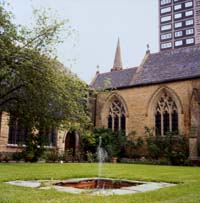What makes a place sacred
 |
 |
 |
Even amidst the concrete blocks of inner city Salford, a sacred place can be discovered |
Examples of what Sacred Land does:
• rediscover ancient holy sites – forgotten holy wells, overgrown trails, sacred forests
• help sacred sites reach their environmental potential
• create new sacred places – for example on council house
estates, in small towns devastated by unemployment and recession and in urban sites where otherwise there is no space for peace or calm
Think about the places in your area that make you feel happy or at peace. Are they enjoyed by other people? Could they be? Are they places that enhance nature? Or could they be made more beautiful?
 |
| Anywhere can be a sacred site – it only requires us to see our land as special and we will learn to tread more gently upon it. |
|
 |
 |
If you have no such places, then think about creating one.
By making people aware of what has been, could be again, or might be created and dreamt of, we are saying to everyone that ANYWHERE is capable of being a sacred space, if only we can see its potential and find ways to realise this vision.
Twenty years ago in Salford, in one of Britain's poorest council estates, a vicar asked an angry young truant why he was so violent.
‘Because I hate all this bloody concrete,’ was the answer.
So Canon David Wyatt of St Paul's Church recruited the boy and other members of the community to transform an abandoned playground near the church – and design a garden. Today it is a beautiful place where people can sit peacefully among mature trees and forget the harsh urban landscape beyond. It has inspired other housing estates to make their own gardens. The young truant became a successful landscape gardener.
|

